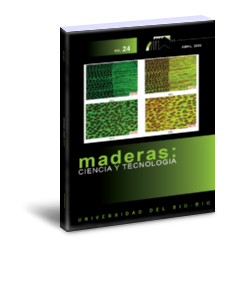Shear strength and hardness of two tropical wood species as function of heat treatment
DOI:
https://doi.org/10.4067/s0718-221x2022000100429Keywords:
Batai, hardness, heat treatment, surface roughness, sesendok, shearAbstract
The aim of this study was to evaluate the effect of heat treatment on surface roughness, shear strength and hardness of two tropical wood species, namely batai (Paraserainthes falcataria) and sesendok (Endospermum malaccensis). Samples were exposed to temperature levels of 120 ºC and 180 ºC for 3 h and 6 h. The surface quality of the control and heat-treated samples were determined using a stylus technique. Hardness and shear strength of the samples were evaluated using Janka hardness and block-shear test, respectively. The results reveal that the surface roughness of batai improved 3 % for 80-grit and 5 % for 180-grit samples while surface roughness of sesendok improved 7 % and 10 % for 80-grit and 180-grit, respectively by the increase of the heat temperature and prolonged durations. Analysis of variance (ANOVA) also revealed that most of the tested properties on the treated wood were significantly affected by the species, girt number and also temperature. In contrast to the untreated wood species, the heat-treated wood species exhibited lower values of shear strength and hardness. Overall, the hardness and shear of both species were adversely influenced by heat exposure.
Downloads
References
Alia Syahirah, Y.; Paridah, M.T.; Hamdan, H.; Anwar, U.M.K.; Nordahlia, A.S.; Lee, S.H. 2019. Effects of anatomical characteristics and wood density on surface roughness and their relation to surface wettability of hardwood. J Trop For Sci 31(3): 269–277. https://doi.org/10.26525/jtfs2019.31.3.269
American Society for Testing and Materials. 2020. ASTM D1037-12: Standard test methods for evaluating properties of wood-base fiber and particle panel materials. ASTM. West Conshohocken, PA, www.astm.org/Standards/D1037.htm
Balkis, B.F.; Hiziroglu, S.; Paridah, M.T. 2013. Properties of some thermally modified wood species. Mater Des 43: 348–355. https://doi.org/10.1016/j.matdes.2012.06.054
Boonstra, M.J.; Van Acker, J., Tjeerdsma, B.F.; Kegel, E.V. 2007. Strength properties of thermally modified softwoods and its relation to polymeric structural wood constituents. Ann For Sci 64: 679–690. https://doi.org/10.1051/forest:2007048
Bhushan, B. 2000. Surface rougness analysis and measurement techniques. In Modern Tribology Handbook. CRC Press, London, UK. https://doi.org/10.1201/9780849377877
Esteves, B.M.; Pereira, H.M. 2009. Wood modification by heat treatment: A review. BioResources 4(1): 370–404. https://dx.doi.org/10.15376/biores.4.1.370-404
Fu, Z.; Zhou, F.; Gao, X.; Weng, X.; Zhou, Y. 2020. Assessment of mechanical properties based on the changes of chromatic values in heat treatment wood. Measurement 152: 107215. https://doi.org/10.1016/j.measurement.2019.107215
Gao, J.; Kim, J.S.; Terziev, N.; Cuccui, I.; Daniel, G. 2018. Effect of thermal modification on the durability and decay patterns of hardwoods and softwoods exposed to soft rot fungi. Int Biodeter Biodegr 127: 35–45. https://doi.org/10.1016/j.ibiod.2017.11.009
Hiziroglu, S.; Suzuki S. 2009. Surface characteristics of overlaid wood composites. J Trop For Sci 21(3): 272-276. https://www.jstor.org/stable/23616807
Hoseinzadeh, F.; Zabihzadeh, S.M.; Dastoorian, F. 2019. Creep behavior of heat treated beech wood and the relation to its chemical structure. Constr Build Mater 226: 220–226. https://doi.org/10.1016/j.conbuildmat.2019.07.181
Hamdan, H.; Iskandar M.; Anwar U.M.K. 2016. Cross laminated timber: production of panel using sesenduk timber species. Timber Technol Bull 59: 1-6. http://myagric.upm.edu.my/id/eprint/11461
Kesik, H.I.; Korkut, S.; Hiziroglu, S.; Sevik, H. 2014. An evaluation of properties of four heat treated wood species. Ind Crops Prod 60: 60–65. https://doi.org/10.1016/j.indcrop.2014.06.001
Korkut, S.; Karayilmazlar, S.; Hiziroglu, S.; Sanli, T. 2010. Some of the properties of heat-treated sessile oak (Quercus petraea). Forest Prod J 60(5): 473–480. https://doi.org/10.13073/0015-7473-60.5.473
Lee, S.H.; Ashaari, Z.; Lum, W.C.; Halip, J.A.; Ang, A.F.; Tan, L.P.; Chin, K.L.; Paridah, M.T. 2018. Thermal treatment of wood using vegetable oils: A review. Constr Build Mater 181: 408-419. https://doi.org/10.1016/j.conbuildmat.2018.06.058
Metsä-Kortelainen, S.; Antikainen, T.; Viitaniemi, P. 2006. The water absorption of sapwood and heartwood of Scots pine and Norway spruce heat-treated at 170 °C, 190 °C, 210 °C and 230 °C. Holz Roh Werkst 64(3): 192–197. https://doi.org/10.1007/s00107-005-0063-y
Muthuraj, R.; Misra, M.; Defersha, F.; Mohanty, A.K. 2016. Influence of processing parameters on the impact strength of biocomposites: A statistical approach. Compos Part A Appl Sci Manuf 83: 120–129. https://doi.org/10.1016/j.compositesa.2015.09.003
Nordahlia, A. S.; Lim, S.C.; Hamdan, H.; Anwar, U.M.K. 2014. Wood properties of selected plantation species : Tectona grandis (Teak), Neolamarckia cadamba (Kelempayan/Laran), Octomeles sumatrana (Binuang) and Paraserianthes falcataria (Batai). Timber Technol Bull 54:1–8. http://myagric.upm.edu.my/id/eprint/11457
Nordahlia, A.; Anwar, U.M.K.; Hamdan, H.; Lim, S.C.; Iskandar, M.; How, S.S. 2018. wood properties of two selected pioneer species: Ludai (Sapium Sp.) and Mahang (Macaranga Sp.). Timber Technol Bull 80: 1–5. https://info.frim.gov.my/infocenter/booksonline/ttb/TTB80.pdf
Ozcan, S.; Ozcifci, A.; Hiziroglu, S.; Toker, H. 2012. Effects of heat treatment and surface roughness on bonding strength. Constr Build Mater 33: 7–13. https://doi.org/10.1016/j.conbuildmat.2012.01.008
Priadi, T.; Hiziroglu, S. 2013. Characterization of heat treated wood species. Mater Des 49: 575–582. https://doi.org/10.1016/j.matdes.2012.12.067
Priadi, T.; Suharjo, A.A.C.; Karlinasari, L. 2019. Dimensional stability and colour change of heat-treated young teak wood. Int Wood Prod J 10(3): 119–125. https://doi.org/10.1080/20426445.2019.1679430
Shukla, S.R. 2019. Evaluation of dimensional stability, surface rougness, colour, flexural properties and decay resistance of thermally modified Acacia auriculiformis. Madera-Cien Tecnol 21(4): 433-446. http://dx.doi.org/10.4067/S0718-221X2019005000401
Tiryaki, S. 2015. Investigating the relationship between some mechanical properties and weight loss in heat treated woods. J Polytechnic 18(3): 149–154. http://doi.org/10.2339/2015.18.3149-154
Ulker, O.; Aslanova, F.; Hiziroglu, S. 2018. Properties of thermally treated yellow poplar, Southern pine, and Eastern redcedar. BioResources 13(4): 7726–7737. https://doi.org/10.15376/biores.13.4.7726-7737
Ulker, O.; Hiziroglu, S. 2017. Some properties of densified eastern redcedar as function of heat and pressure. Materials 10(11): 1275. https://doi.org/10.3390/ma10111275
Yang, T.H.; Chang, F.R.; Lin, C.J.; Chang, F.C. 2016. Effects of temperature and duration of heat treatment on the physical, surface, and mechanical properties of Japanese cedar wood. BioResources 11(2): 3947–3963. https://doi.org/10.15376/biores.11.2.3947-3963
Downloads
Published
How to Cite
Issue
Section
License

This work is licensed under a Creative Commons Attribution 4.0 International License.
Los autores/as conservarán sus derechos de autor y garantizarán a la revista el derecho de primera publicación de su obra, el cuál estará simultáneamente sujeto a la Licencia de Reconocimiento de Creative Commons CC-BY que permite a terceros compartir la obra siempre que se indique su autor y su primera publicación esta revista.




































